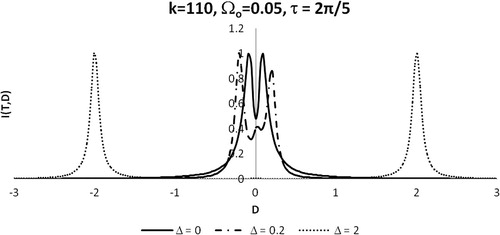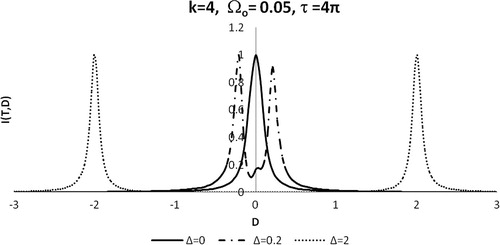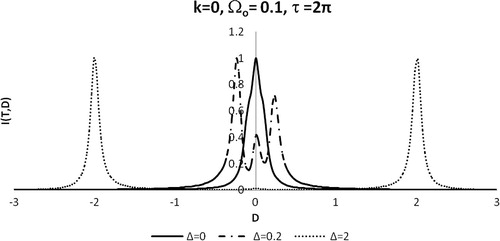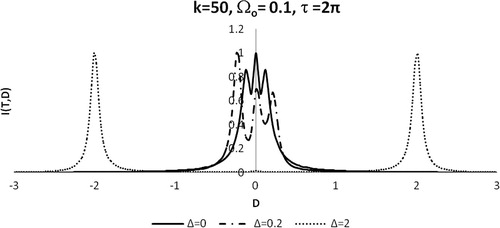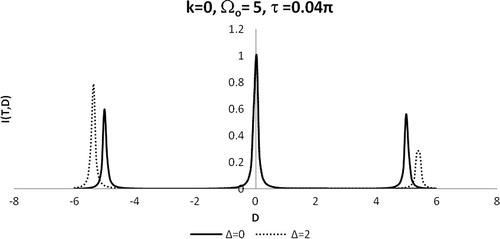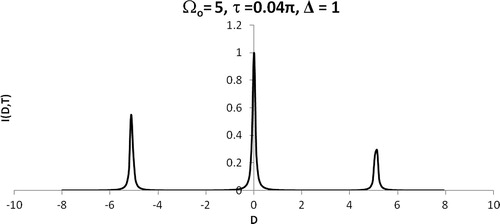Abstract
The transient scattered radiation due to interaction of a short laser pulse (of rectangular shape) with a qubit is studied through the Haar wavelet window spectrum. Asymmetrical structure in the spectrum is shown due to frequency miss-match of the laser and qubit frequencies and the shift window parameter.
1 Introduction
Analyzing the scattered radiation due to the interaction of a single qubit (taken as spin--level atom system) with a short laser pulse is one of the many basic studies in signal information processing. Within a quantum framework the (transient) scattered radiation, known as fluorescent spectrum, is quantified as the Fourier transform (FT) of the auto-correlation function of the induced atomic dipoles (Mollow, Citation1969; Eberly and Wodkiewicz, Citation1977; Eberly, Citation1984). Transient florescent spectra of 2-level atomic systems (qubits) driven by different shapes of laser pulses (e.g., rectangular, triangular, etc. Newbold and Saloma, Citation1980; Rzazewski and Florjanczyk, Citation1984; Florjanczyk et al., Citation1985; Haus et al., Citation1984; Rodgers and Swain, Citation1991; Joshi and Hassan, Citation2002; Hassan et al., Citation2008, Citation2010) have been studied in detail.
In the usual Fourier analysis, a signal is represented as sum of sinusoidal functions of various frequencies. This is suitable for signals that change very slowly with time or for very noisy signals that change regularly with time (David, Citation2000; Addison, Citation2004). For non-stationary signals and signals with sudden change, Fourier analysis averaging over the entire length of the signal and hence the fixed time-width windowed FT has its limitation, as some “fine” detail is lost. Such “fine detail” or time localization analysis of different frequency components of a given signal is called wavelet transform (Croca, Citation2003). With windowed wavelet transform, the time width is adjusted to the frequency in such a way that high frequency wavelets will be narrow and vice-versa (Feruandez and Rojas, Citation2002). For resonant rectangular pulsed-driven qubit models, wavelet transform of the scattered radiation has been examined with different window functions: Morlet’s and Mexican hat wavelets (Mohamed et al., Citation2007) and Haar wavelet (Hassan et al., Citation2011).
In the present work, we examine the transient fluorescent Haar wavelet spectrum of a single qubit excited by a non-resonant rectangular laser pulse and compare the results with the corresponding ones for the resonant case (Hassan et al., Citation2011). The paper is presented as follows in Section 2, we present the essential analytical formulas for the Haar wavelet spectrum, followed by discussion of computational plots in Section 3. A summary is given in Section 4.
2 Haar wavelet transient spectrum
For a single qubit excited by a short laser pulse, the general form of the transient scattered radiation is given by (Eberly and Wodkiewicz, Citation1977; Rodgers and Swain, Citation1991).(1) Where
is the quantum average of the atomic dipole–dipole spin auto-correlation function with
are the atomic spin-up (down) operators and H(t) is the (filter) window function of the radiation detector. For the case of narrow Lorentzian filter, it has the form
(2) Where ωf and Γ are the central frequency and width of the filter, respectively. With the narrow window function Equation(2)
(2) the filter “sees” the detected field in the Fourier domain (Eberly, Citation1984). The investigation of the current model for the transient FT spectrum (i.e., Equation(1)
(1) with Equation(2)
(2) ) is given in (Rodgers and Swain, Citation1991; Joshi and Hassan, Citation2002). Now, in the present case, the Haar wavelet window function Hh(t) is given by (Rodgers and Swain, Citation1991, references therein),
(3) Where the Ψ(t) is the mother wavelet function,
(4a) Where a < b < c, are given by,
(4b) With j and k are the dilation and shift parameters respectively. The filler’s frequency (ωf) and width (Γ) parameters have been introduced via the exponential factor in Equation(3)
(3) . For a short laser pulse the interaction with the qubit takes place in the absence of any damping process. In the case of a rectangular laser pulse, the expression for the dipole auto-correlation function for initially ground state atom is given by (Hassan et al., Citation2008),
(5) With the C-number functions C−,z(t) are given by
(6) Where
, Ωo is the (real) Rabi frequency associated with the laser pulse and Δ = (ωa − ωL) is the frequency detuning between the atomic transition frequency (ωa) and the circular frequency (ωL) of the laser pulse.
Inserting the expression (2–6) into the formula Equation(1)(1) , we have the Haar wavelet transient spectrum at the end of pulse duration, t = T in the form,
(7)
(8a)
(8b) With D = ωL − ωf is the filter’s detuning parameter. Note that, the parameter (2−jk) can be considered as an effective shift parameter. At exact resonance Δ = 0 the expressions (8) reduce to those in (Hassan et al., Citation2011).
3 Discussion of results
Here, we present the plotting of the normalized spectrum I(T,D) = S(T,D)/Smax(T,D) in after normalizing the parameters Ωo,D, by (Γ). We use the same data in (Hassan et al., Citation2011) in order to see the effect of the atomic detuning on the structure of the spectrum.
For weak pulse strength Ωo = 0.05 and τ = T − 2−jk = 2π/5,k = 0 the single narrowed Lorentzian at D = 0 (Hassan et al., Citation2011) turns to asymmetrical splitting for small atomic detuning, Δ = 0.2 (), with asymmetry reversed for Δ = −0.2. For larger Δ = 2 the spectrum turns to two separate peaks (almost symmetrical) at D = ± 2. For a larger shift parameter k = 110 where the dip structure at D = 0 (Hassan et al., Citation2011) shows reversed asymmetry compared with and turns to separate peaks for increasing D (). For larger τ = 4π,k = 4 (), the asymmetry of splitted peaks with small Δ = 0.2 is reduced compared with .
Figure 1a Transient Haar wavelet normalized spectrum I(τ, D) verses the filter’s detuning parameter D for Ω0 = 0.05, τ = 2π/5, k = 0 and various values of atomic detuning Δ = 0,0.2,2.

For relatively larger Ωo = 0.1, τ = 2π, the ‘pencil’ shaped Lorentzian at resonance Δ = D = 0 (Hassan et al., Citation2011) for k = 0 splits to 3-unequal peaks with small Δ = 0.2 (). With larger k = 50, the same splitting feature occurs for the “top” 3-peak structure for Δ = 0 (Hassan et al., Citation2011) – ().
For strong pulse strength Ωo = 5, τ = π/4, k = 0 the symmetrical 3-peak Mollow structure gets asymmetrical for Δ ≠ 0 (). At fixed Δ = 1, the asymmetrical 3-peak structure is unaffected by the shift parameter k (), unlike the weak pulse case.
4 Summary
For rectangular pulsed-driven qubit, initially in its ground state the Haar wavelet spectrum is symmetric at exact atomic resonance Δ = 0, for arbitrary values of pulse strength (Ωo) shift parameter (k), and the effective time parameter (τ) (Hassan et al., Citation2011). The effect of non-zero atomic detuning (Δ ≠ 0) is as follows:
| 1. | For a weak pulse and k = 0, asymmetry is more pronounced for small ∣Δ∣ < 1 and it is reversed with larger shift parameter (k). For larger ∣Δ∣ = 2 aibitrary k,τ the spectrum splits into two symmetrical peaks at ∣D∣ = 2. | ||||
| 2. | For a strong pulse, asymmetry shows in the two-side bands of the Mollow spectrum for Δ ≠ 0 and k ⩾ 0. | ||||
Finally we add that, for other initial atomic state preparation (e.g., coherent state) the Fourier spectrum at EXACT atomic resonance shows pronounced asymmetry on its profile due to the Rabi oscillations and their interference, which is caused by the initial coherent dispersion of the atomic polarization . Due to the lengthy analytical expressions for an initial atomic coherent state with non-zero atomic detuning, the results will be analysed with computational display in a separate presentation.
Acknowledgements
The author acknowledges the support of the University of Bahrain, research project (No. 2011/32). The author also acknowledges fruitful discussion with Prof. S.S. Hassan (University of Bahrain).
Notes
Peer review under responsibility of University of Bahrain.
References
- Addison, P., 2004. Physics world, (March issue) pp. 35–39.
- J.R.CrocaTowards a Nonlinear Quantum Physics2003World ScientificLondon
- W.K.DavidA First Course in Fourier analysis2000Prentice HallNY
- J.H.EberlyK.WodkiewiczJ. Opt. Soc. Am.6719771252
- J.H.EberlyA.O.BarutQuantum Electrodynamics and Quantum Optics1984Academic PressNY209227
- Feruandez, R.M.C., Rojas, H.N.D., 2002. An overview of wavelet transforms application in power system. In: Proc. of 14th PSCC, Sevilla (June 24–28).
- J.FlorjanczykK.RzazewskiJ.ZakerzewskiPhys. Rev. A3119851558
- S.S.HassanA.JoshiM.M.Al-MadahariJ. Phys. B412008145503 Corrigendum (2009) J. Phys. B. 42, 089801
- S.S.HassanA.JoshiH.A.BatarfiInt. J. Theor. Phys., Group Theor. Nonlinear Opt.132010371
- S.S.HassanM.A.Al-SaeghA.A.S.MohamedH.A.BatarfiNonlinear Opt., Quantum Opt.4220113750
- J.W.HausM.LewensteinK.RzazewskiJ. Opt. Soc. Am. B19841641
- A.JoshiS.S.HassanJ. Phys. B3520021985
- A.A.S.MohamedS.S.HassanM.A.Al-SaeghNonlinear Opt., Quantum Opt.362007107116
- B.R.MollowPhys. Rev.18819691969
- M.A.NewboldG.J.SalomaPhys. Rev. A2219802098
- P.A.RodgersS.SwainOpt. Commun.811991291
- K.RzazewskiM.FlorjanczykJ. Phys. B: At., Mol. Phys.171984L509
